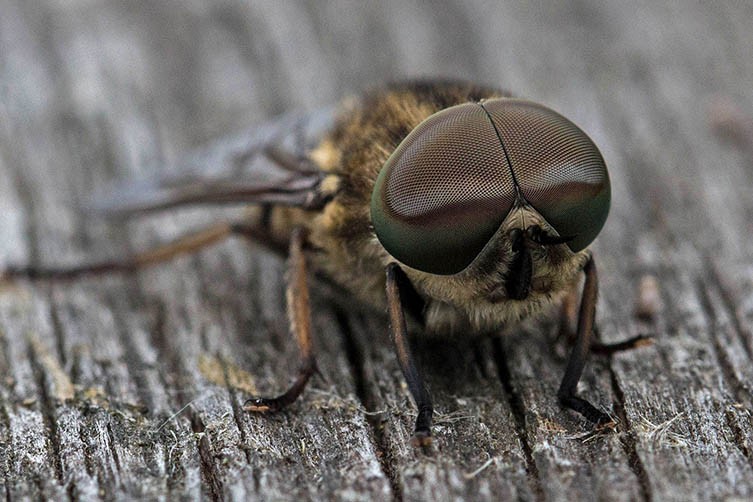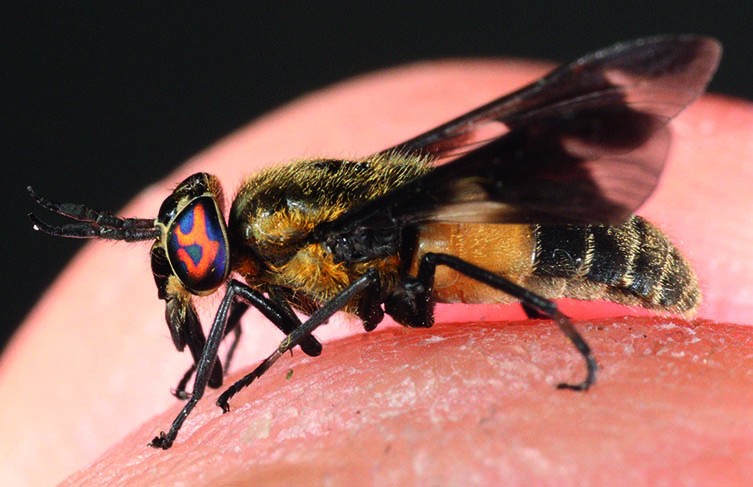Horse flies bite because they require a blood meal to develop their eggs, and at WHY.EDU.VN, we understand your curiosity about these pesky insects. This comprehensive guide explores the reasons behind horse fly bites, how to identify them, effective prevention strategies, and what to do if you’ve been bitten. Discover expert advice and practical tips to protect yourself from horse flies and learn about the vital role these insects play in the ecosystem. Delve deeper into insect behavior, bite prevention, and wildlife education.
Table of Contents
- 1. The Science Behind Why Horse Flies Bite
- 2. Identifying Horse Flies: What to Look For
- 3. Understanding Horse Fly Bites: Symptoms and Reactions
- 4. Effective Strategies to Avoid Horse Fly Bites
- 5. Treating Horse Fly Bites: Relief and Recovery
- 6. The Role of Horse Flies in the Ecosystem
- 7. Horse Flies vs. Other Biting Insects
- 8. Debunking Myths About Horse Flies
- 9. Global Distribution of Horse Flies
- 10. Recent Research and Studies on Horse Flies
- 11. Expert Opinions on Managing Horse Fly Bites
- 12. Resources for Further Learning
- 13. FAQ: Common Questions About Horse Flies
- 14. Conclusion: Coexisting with Horse Flies
1. The Science Behind Why Horse Flies Bite
Why do horse flies bite? The answer lies in the female horse fly’s need for blood to reproduce. Horse fly biting habits are driven by the necessity of protein-rich blood for egg development. Understanding the biology behind these bites can help you take effective preventive measures. Learn more about insect biology, biting flies, and natural history.
1.1. Female Horse Flies: The Culprits
Only female horse flies bite because they require a blood meal to develop their eggs. According to Dr. Daniel Whitmore, Senior Curator of Diptera and Siphonaptera at the Natural History Museum, “They need a high protein input to help develop their eggs after fertilization.” Male horse flies, on the other hand, feed on nectar and pollen.
1.2. The Biting Mechanism: A Brutal Reality
Unlike mosquitoes that use a precision-like proboscis to draw blood, horse flies employ a more crude and painful method. They use serrated mandibles to saw into the skin, cutting until they break small blood vessels. The horse fly then laps up the blood. An anticoagulant in the fly’s saliva prevents the blood from clotting during this process. This mechanical action of cutting into the skin is what makes horse fly bites particularly noticeable and often more painful than other insect bites.
1.3. Why Horse Fly Bites Hurt So Much
Horse fly bites are notoriously painful for a few reasons. First, unlike mosquitoes that inject a mild anesthetic when they bite, horse flies do not. Second, the crude cutting action of their mandibles causes more tissue damage than the piercing action of a mosquito’s proboscis. This combination of no anesthetic and significant tissue damage results in a bite that is immediately painful and can continue to be sore for several days. The body’s immune response to the bite also contributes to the pain and inflammation.
2. Identifying Horse Flies: What to Look For
Being able to identify a horse fly can help you take precautions to avoid being bitten. Recognition of these insects is key to protection.
2.1. Size and Appearance
Horse flies are typically larger than many other biting flies, often ranging from 0.5 to 1.2 inches in length. They have stout bodies and are usually gray or brown in color. One of the most distinguishing features of horse flies is their large, often colorful and patterned eyes. In male horse flies, the eyes are so large that they touch at the top of the head.
Alt: Male horsefly with large eyes touching at the top of its head, perched on a piece of wood, illustrating its distinct physical features.
2.2. Habitat and Breeding Grounds
Horse flies are commonly found near bodies of water such as ponds, rivers, and streams because many species lay their eggs on plants growing in these areas. The larvae of some species are aquatic, while others live in damp soil. Farms are also frequently hotspots for horse flies because they are attracted to cattle and horses. Knowing where horse flies are likely to be found can help you avoid areas with high concentrations of these insects.
3. Understanding Horse Fly Bites: Symptoms and Reactions
Understanding the symptoms and potential reactions to horse fly bites is crucial for proper care and knowing when to seek medical assistance. Learn about insect bites, health advice, and medical information.
3.1. Common Symptoms of a Horse Fly Bite
The most common symptom of a horse fly bite is a raised, red area of skin that may be painful and sensitive to the touch. The bite area may also itch. These reactions are due to the body’s response to the fly’s saliva, which contains anticoagulants and other substances that can irritate the skin.
3.2. When to Seek Medical Attention
In most cases, horse fly bites can be treated at home. However, it’s essential to seek medical attention if you experience any of the following symptoms:
- Severe pain or swelling
- Signs of infection, such as increased redness, warmth, or pus
- Dizziness or weakness
- Difficulty breathing
- Hives or rash
These symptoms could indicate a severe allergic reaction or an infection that requires medical treatment.
3.3. Allergic Reactions and Anaphylaxis
Although rare, some people may experience an allergic reaction to horse fly bites. In extreme cases, this can lead to anaphylaxis, a severe and potentially life-threatening allergic reaction. Symptoms of anaphylaxis include:
- Difficulty breathing or wheezing
- Swelling of the face, lips, or tongue
- Hives
- Dizziness or loss of consciousness
If you experience any of these symptoms after being bitten by a horse fly, seek immediate medical attention.
4. Effective Strategies to Avoid Horse Fly Bites
Preventing horse fly bites involves several strategies, including covering up, using insect repellents, and avoiding peak activity times. Explore protection methods, outdoor safety, and insect control.
4.1. Cover Up: Clothing and Protection
One of the simplest ways to avoid horse fly bites is to cover up your skin with clothing. However, according to Dr. Daniel Whitmore, “Horsefly females have such strong, powerful mouthparts that they can sometimes bite you through your clothes. But obviously, they are more likely to go for bare skin.” It’s best to opt for loose-fitting, light-colored clothing, as horse flies are attracted to dark colors.
4.2. Insect Repellents: Which Ones Work?
Insect repellents containing DEET, picaridin, or oil of lemon eucalyptus can be effective in repelling horse flies. Apply the repellent to exposed skin, following the manufacturer’s instructions. Reapply as needed, especially after sweating or being in water.
4.3. Timing and Location: Avoiding Peak Activity
Horse flies are most active during the warmer months, particularly in the late spring and summer. They are also more active during the day, especially in sunny conditions. Avoid being outdoors during peak activity times, particularly near bodies of water or in areas with livestock.
4.4. Other Preventive Measures
Other preventive measures include:
- Using screens on windows and doors to keep horse flies out of your home.
- Avoiding wearing strong perfumes or scented lotions, which can attract horse flies.
- Using horse fly traps in areas where horse flies are prevalent.
- Keeping your yard free of standing water, which can provide breeding grounds for horse flies.
5. Treating Horse Fly Bites: Relief and Recovery
Knowing how to treat horse fly bites can help alleviate discomfort and prevent complications. Learn about first aid, skin care, and health tips.
5.1. Immediate First Aid
If you are bitten by a horse fly, the first step is to wash the bite area with soap and water. This can help prevent infection. Avoid scratching the bite, as this can also increase the risk of infection.
5.2. Over-the-Counter Remedies
Over-the-counter remedies can help relieve the itching and inflammation associated with horse fly bites. These include:
- Antihistamine creams or lotions
- Calamine lotion
- Hydrocortisone cream
Apply these remedies according to the manufacturer’s instructions.
5.3. Home Remedies for Relief
Several home remedies can also provide relief from horse fly bites, including:
- Applying a cold compress to the bite area
- Making a paste of baking soda and water and applying it to the bite
- Applying honey to the bite, as it has antibacterial and anti-inflammatory properties
- Using aloe vera gel to soothe the skin
6. The Role of Horse Flies in the Ecosystem
Despite being a nuisance to humans and animals, horse flies play an important role in the ecosystem. Understand their ecological significance, biodiversity, and wildlife conservation.
6.1. Pollinators and Nectar Feeders
While female horse flies feed on blood, male horse flies feed on nectar. In some cases, the flies can be crucial pollinators, coevolving with the plants on which they feed. “There are some species of horsefly in which both sexes have extremely elongated mouthparts to suck nectar out of long-tubed flowers,” explains Dr. Daniel Whitmore. This entwined relationship is thought to be involved in driving new species of flowers to evolve, and vice versa.
Alt: A horsefly perched on human skin, highlighting its distinctive eyes and illustrating its role as both a blood feeder and potential pollinator.
6.2. A Food Source for Other Animals
Along with many other flying insects, horse flies are also a key food source for many other animals higher up the food chain. They help underpin other, more charismatic species such as bats and birds, while the aquatic larvae of the insects feed fish.
6.3. Biodiversity and Ecological Balance
Horse flies are an important aspect of the wider ecosystem. While they may plague us during the summer months, they contribute to the biodiversity and ecological balance of their habitats.
7. Horse Flies vs. Other Biting Insects
It’s helpful to distinguish horse flies from other biting insects to better understand the risks and how to avoid them. Learn about insect identification, pest control, and comparative entomology.
7.1. Horse Flies vs. Mosquitoes
Horse flies and mosquitoes are both biting insects that feed on blood, but they differ in several ways. Horse flies are larger than mosquitoes and have a more painful bite. Mosquitoes inject a mild anesthetic when they bite, while horse flies do not. Mosquitoes also transmit diseases such as malaria and West Nile virus, while horse flies are not known to transmit diseases to humans.
Table: Comparison of Horse Flies and Mosquitoes
| Feature | Horse Fly | Mosquito |
|---|---|---|
| Size | Larger | Smaller |
| Bite Pain | More painful | Less painful |
| Anesthetic | No | Yes |
| Disease Vector | No | Yes (Malaria, West Nile) |
| Feeding Habits | Cuts skin and laps up blood | Pierces skin and sucks blood |


7.2. Horse Flies vs. Deer Flies
Deer flies are similar to horse flies but are typically smaller and have dark bands on their wings. Deer flies are also more likely to bite humans than horse flies. Like horse flies, deer flies have a painful bite and can be a nuisance in outdoor areas.
7.3. Horse Flies vs. Black Flies
Black flies, also known as buffalo gnats, are small, dark flies that are known for their irritating bites. Black flies typically bite around the head and neck and can cause intense itching and swelling. Unlike horse flies, black flies often bite in swarms, making them particularly bothersome.
8. Debunking Myths About Horse Flies
Several myths surround horse flies, and debunking these misconceptions can lead to better understanding and prevention. Explore fact vs. fiction, insect lore, and scientific accuracy.
8.1. Myth: Horse Flies Only Bite Horses
One common myth is that horse flies only bite horses. While horse flies are attracted to horses and other large mammals, they will also bite humans and other animals. The name “horse fly” is derived from their common association with horses, but they are not exclusive to them.
8.2. Myth: All Horse Flies Bite
Another myth is that all horse flies bite. In reality, only female horse flies bite because they need blood to develop their eggs. Male horse flies feed on nectar and pollen and do not have the mouthparts necessary to bite.
8.3. Myth: Horse Fly Bites Are Always Dangerous
While horse fly bites can be painful and irritating, they are not always dangerous. In most cases, the bites can be treated at home with over-the-counter remedies. However, in rare cases, horse fly bites can cause allergic reactions or infections that require medical treatment.
9. Global Distribution of Horse Flies
Horse flies are found in many parts of the world, and understanding their distribution can help you anticipate their presence in different regions. Learn about geographical entomology, regional pests, and global wildlife.
9.1. Horse Flies in North America
Horse flies are widespread in North America, with many different species found throughout the continent. They are particularly common in areas with wetlands, forests, and livestock.
9.2. Horse Flies in Europe
Europe is also home to several species of horse flies, which are commonly found in rural areas with farms and bodies of water.
9.3. Horse Flies in Asia and Other Regions
Horse flies are found in many other regions around the world, including Asia, Africa, and South America. The specific species of horse flies vary depending on the region, but they all share the common characteristic of being biting insects that feed on blood.
Table: Global Distribution of Horse Flies
| Region | Common Habitats |
|---|---|
| North America | Wetlands, forests, areas with livestock |
| Europe | Rural areas, farms, near bodies of water |
| Asia | Varied, depending on the specific region |
| Africa | Varied, often near water sources |
| South America | Similar to North America, near water and forests |
10. Recent Research and Studies on Horse Flies
Recent research and studies have shed new light on horse fly behavior, prevention, and treatment. Stay updated with scientific research, entomology news, and medical advances.
10.1. New Discoveries in Horse Fly Behavior
Recent studies have uncovered new insights into horse fly behavior, including how they locate their hosts and what attracts them. For example, some research suggests that horse flies are attracted to dark colors and exhaled carbon dioxide.
10.2. Advances in Bite Prevention and Treatment
Advances in bite prevention and treatment have led to the development of more effective insect repellents and remedies for horse fly bites. New research is also exploring the potential of using natural compounds to repel horse flies.
10.3. Impact of Climate Change on Horse Fly Populations
Climate change is expected to have an impact on horse fly populations, with warmer temperatures potentially leading to an increase in their range and activity. Understanding these impacts is crucial for developing effective strategies to manage horse fly populations in the future.
11. Expert Opinions on Managing Horse Fly Bites
Hearing from experts in entomology and medicine can provide valuable insights into managing horse fly bites. Get advice from professionals, health recommendations, and pest management strategies.
11.1. Entomologists’ Perspectives
Entomologists emphasize the importance of understanding horse fly behavior and ecology in order to develop effective strategies to prevent bites. They also highlight the role that horse flies play in the ecosystem and the need to balance pest management with conservation efforts.
11.2. Medical Professionals’ Advice
Medical professionals advise that most horse fly bites can be treated at home with basic first aid and over-the-counter remedies. However, they stress the importance of seeking medical attention if you experience signs of infection or an allergic reaction.
12. Resources for Further Learning
To deepen your understanding of horse flies, here are some valuable resources for further learning. Explore educational materials, scientific databases, and local expertise.
12.1. Books and Publications
- “Medical Entomology” by Mullen and Durden
- “A Field Guide to Common Texas Insects” by Bastiaan M. Drees and John A. Jackman
- Scientific journals such as the “Journal of Medical Entomology”
12.2. Online Databases and Websites
- The Natural History Museum (http://www.nhm.ac.uk/)
- The Centers for Disease Control and Prevention (CDC) (http://www.cdc.gov/)
- University Extension websites
12.3. Local Extension Offices
Contacting your local extension office can provide valuable information about horse flies in your area and recommendations for managing them.
13. FAQ: Common Questions About Horse Flies
Q1: Why do horse flies bite?
A1: Female horse flies bite to obtain blood, which they need to develop their eggs.
Q2: Are horse fly bites dangerous?
A2: Most horse fly bites are not dangerous and can be treated at home. However, in rare cases, they can cause allergic reactions or infections.
Q3: How can I avoid horse fly bites?
A3: You can avoid horse fly bites by covering up your skin, using insect repellent, and avoiding peak activity times.
Q4: What should I do if I am bitten by a horse fly?
A4: Wash the bite area with soap and water, apply an over-the-counter remedy, and avoid scratching the bite.
Q5: Are horse flies important to the ecosystem?
A5: Yes, horse flies play a role in pollination and serve as a food source for other animals.
Q6: Can horse flies transmit diseases?
A6: Horse flies are not known to transmit diseases to humans.
Q7: What attracts horse flies?
A7: Horse flies are attracted to dark colors, exhaled carbon dioxide, and large mammals.
Q8: Do male horse flies bite?
A8: No, only female horse flies bite. Male horse flies feed on nectar and pollen.
Q9: Are horse flies found all over the world?
A9: Horse flies are found in many parts of the world, but their distribution varies depending on the species and region.
Q10: How big are horse flies?
A10: Horse flies typically range from 0.5 to 1.2 inches in length.
14. Conclusion: Coexisting with Horse Flies
While horse flies can be a nuisance, understanding their behavior and role in the ecosystem can help you coexist with them more effectively. By taking preventive measures and knowing how to treat bites, you can minimize the impact of horse flies on your outdoor activities. Remember, these insects are also a part of the natural world, contributing to pollination and serving as a food source for other animals.
At WHY.EDU.VN, we strive to provide you with accurate and comprehensive answers to your questions. If you have more questions about horse flies or any other topic, please don’t hesitate to reach out to us. Visit our website at WHY.EDU.VN or contact us at 101 Curiosity Lane, Answer Town, CA 90210, United States, or via WhatsApp at +1 (213) 555-0101. Our team of experts is here to help you find the answers you need. Discover, learn, and explore with why.edu.vn.

